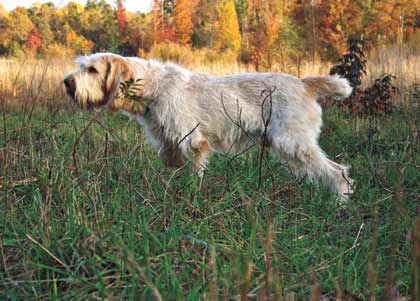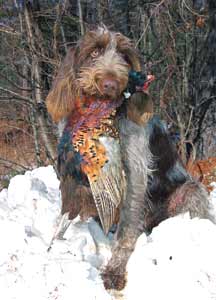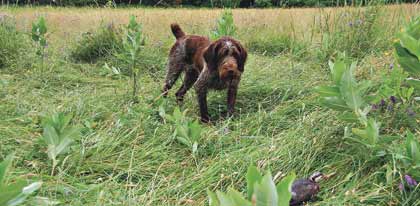The Spinone: One Of The Oldest (And Most Hunter-Savvy) Gun Dog Breeds Comes To North America.
By M.J. Nelson
 Ch. Epithelium Elia, an Italian field champion imported by Ed and Suzanne Applegate, pointing quail in Virginia. |
Once upon a time long ago in Il Bel Paese, as Italians lovingly call their home country, there lived a grumpy-looking, light-colored, shaggy-haired dog. These dogs were greatly prized by Italian hunters because they pointed game, were excellent retrievers even in cold deep water, hunted close and possessed the unusual trait of sneaking virtually silently after moving birds.
Although it is believed to be one of the oldest breeds of gun dog in existence today, the dogs did not acquire a formal, official name until the early nineteenth century. Before then, hunters in some areas called the dogs "Spinoso." Finally, someone decided to call these dogs Spinone after a thornbush called the pino, a favorite hiding place for small game, because these bushes were virtually impenetrable by larger animals.
Only a thick-skinned, coarse-coated animal could fight through the branches and emerge unscathed by the thorns. The Spinone was the dog breed most capable of getting through the pinos and as a result, earned the name.
Because the breed is so old, its origins are not known. There are almost as many theories as to the breed's origin as there are Spinoni. Depending upon whom you ask, the breed originated in Italy, France, Spain, Russia, Greece or Celtic Ireland. As to what breeds contributed to the development of the Spinone€¦again, depending upon whom you ask, the breed descended from the now-extinct Spanish pointer, the ancient Russian setter, or another coarse-coated setter brought to Italy by Greek traders during the heyday of the Roman Empire.
If you ask the French, the Spinone descended from crosses of several French pointing breeds, while the Italians contend that the Spinone was the ancestor of the wirehaired pointing griffon, the German wirehaired pointer and the pudelpointer. Almost any one of these theories could be correct and perhaps several of them are. What is known is that during World War II, the breed nearly became extinct. It wasn't until the 1950s that a serious effort began to restore the breed.
One trait that especially has endeared this breed to many hunters is its willingness to work with the person carrying the shotgun. "These dogs are very willing to work with hunters," said Ed Applegate, who owns several Spinoni (that's the plural form), including a number that have hunt test titles and are also conformation champions. "They maintain contact with you and are not prone to become self hunters. They are a good foot hunter's breed. While they can range out as far as any of the versatile breeds, their natural tendency is to work at medium range or within gun range."
The first question any hunter asks when considering a new breed is, how difficult are these dogs to train? "My initial response would be that they are 'different,'" said Liz Bodell. "They can be very soft but they're also extremely smart. They never forget anything so if you do something wrong, you have their lifetime to regret it.
"I have also found different lines to be very, very different in terms of ability and trainability. To me, the females, overall, have been much harder to train than the males. All of them, male or female, have minds of their own and you have to convince them there is a good reason for doing the task the way you want it done."
Applegate noted that while the breed has frequently been classified as "soft," he believes that is more a reflection of the Spinone's refusal to respond to harsh training methods than any real softness in the breed. "Part of the perception that the breed is soft is due, I think, to their natural willingness to work with the hunter. Under that 'soft' exterior, however, is a tough dog that will continue to work through many repetitions until they get it right. 'Getting it right' requires consistent training, though, as they can have a stubborn streak when they decide they would rather do it their own way instead of how you want them to do something.
 Spinoni are capable retrievers in a variety of conditions, as demonstrated by Capo di Paura Dash 4 Cash JH, owned by Ginny Raho and Liz Bodell. |
"They will take advantage of any trainer who relinquishes control to throw in a major dash of their own creativity. They do not respond well at all to harsh training and will turn off and refuse to perform. By harsh training, I don't necessarily mean that you can't use an electronic collar on a Spinone. Actually, they respond extremely well to e-collars provided the trainer knows how to use them correctly. One thing you can never do with a Spinone is fail to control your own temper when you are training them because that can lead to major problems."
While these are relatively large dogs, (the standard says 22 to 27 inches in height and weight ranging from 61 to 85 pounds) they are unusually cautious in their hunting techniques. When they pick up scent, they slow down to the point where they often test the ground with a paw before putting it down in order to make not the slightest sound. If at all possible, they avoid dry branches and leaves so as not to completely reveal their position to the game.
"The true Spinone hunting style is much different than any of the other pointing breeds," said Bodell. "The breed which would be most similar to the Spinone would be the wirehaired pointing griffon. Spinoni trot with their heads held high, tail flicking side to side and zigzagging into the wind. Only when you first start hunting will they actually gallop if they are working correctly.
"They should gradually slow down when they wind a bird and cautiously freeze up on point. They have amazing noses and can wind a bird a long way away. To be perfectly frank, it is not easy to find Spinoni in this country that hunt in the absolute correct Spinone manner."
Applegate agreed that the breed most similar in style to the Spinone is the WPG. "Spinoni were developed for an all-day foot hunt in extremely tough hill and mountain terrain so a steady trot or loping gait is characteristic rather than the blazing speed you find with most pointers and GSPs. The style of a Spinone in the field more closely resembles that of a griffon than that of one of the fast, flashy pointing breeds."
As is the case with many sporting breeds, the Spinone is not free of health problem
s. A major issue for the breed is cerebellar ataxia (CA), a genetic neurological disease that affects coordination and balance in pups. Those actually suffering from the disease generally die or are euthanized before they are a year old and as a result, never get the opportunity to pass along their genetic flaw. However, their littermates not affected by the disease still may be carriers. (Mendel's laws say that 25 percent of the offspring from two carriers will get the disease, 50 percent will not have the disease but will carry the flawed gene and if mated will pass it along to half of their offspring and 25 percent will be completely free of the disorder.)
The United Kingdom Animal Health Trust, working in conjunction with the Italian Spinone Club of Great Britain, recently developed a test for CA, and the Spinone Club of America is actively testing all breeding stock to determine the prevalence of CA within the breed. Before buying a puppy, it would be wise to go to the SCOA's webpage for a list of known carriers and then check the pup's pedigree for the presence of any of these dogs.
 A young Spinone locks up on a chukar during a training session. The dogs typically proceed cautiously when scenting birds in the field. |
Also, like many large breeds, the Spinone is subject to hip dysplasia. For this reason, it is important to make sure both the sire and dam have been x-rayed and have received a rating and number from the Orthopedic Foundation for Animals (OFA) or that they have a PennHip number.
This is a relatively rare breed in the United States, with only 297 registered with the AKC in 2006. Finding a puppy can be a challenge. However, the national breed club does have a list of breeders and available litters (www.spinoneus.org). "You can also go to the NAVHDA website as that's a source of information on breeders and performance," said Applegate. "Attending local NAVHDA and AKC hunt tests where Spinoni are being run can also provide leads for a litter."
"You really need to do your homework," Bodell adds. "The lines are very different in terms of ability. If the parents have NAVHDA titles, go to the website and check their test scores. Make sure the bitch hunts and if possible, watch her hunt even if it is only on a preserve.
"We have been lucky enough to have two that were naturally steady until the shot and naturally retrieved to hand. While that is the way they all should be, some are not. Both of these dogs had the same dam but different sires, which is why it's important to see the female at work. Then, make sure they have all the health clearances."






